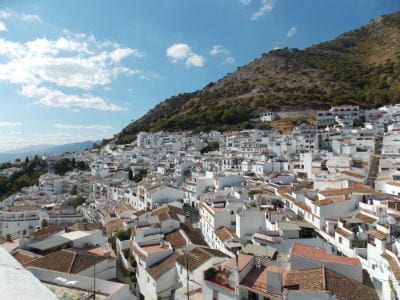THERE are two main types of tourist who visit Mijas pueblo. The ‘watch-everything-through-your-camera-lens type’ and the others, who try and avoid them at all costs.
The latter spend their days seeking out authenticity, while the former are so eager to document everything going on and tick boxes that they often forget to actually enjoy themselves.
What is striking about Mijas is its ability to satisfy these types of tourists and a lot more genres to boot.
For starters, anyone interested in Andalucian history will love its municipal museum and well preserved churches, while foodies and wine lovers are increasingly finding themselves spoilt for choice with a growing range of decent places to ‘tapear’ in the centre.
Above all, being a tourist in Mijas is easy. The town hall and tourist office has it down to a tee. Maps and walking-tours are carefully planned and signposted, with the translations at its sites – for once – making perfect sense in English.
I set off following a yellow line walking tour that snaked through the town, promising to show off the best of the town.
Among the initial highlights of the tour is the shrine of the Virgin of the Rock, a cross-between a cave and a chapel carved out of the mountainside, dedicated to the patron saint of Mijas.
From the nearby El Compas viewpoint, you can take in the phenomenal panoramic views across the Costa that form the backdrop to the shrine.
You could linger here all morning, admiring this leafy haven and enjoying drinks at the small cafes lining the walls of the vantage point.
But the walking-tour marches on, enticing us towards the central hub, Constitution Square. The second plaza is less concerned with cafes, and is definitely the commercial centre of the town.
Countless streets radiate out, lined with artisanal shops – packed with ceramics and trinkets – that seem to have grown out of the mountainside itself.
The haphazard development of Mijas leaves the impression of organic growth – shops come in all shapes and sizes, adapting themselves to the natural landscape.
From here the route slopes upwards, in the direction of the bullring, unusual due to its oval shape, and surrounding gardens.
Ceramic designs on the walls commemorate some of the history of the bullring, built in 1900, as well as some the best-known matadors that have performed there – including Paquirri and Paloma Linares.
During the summer months, there is the occasional bullfight and horse-shows on Sundays, but during the winter visitors can still tour the inside and admire the architecture.
It wasn’t long after the bullring that I fell off the walking tour map and was forced to start exploring for myself.
However, it’s in getting lost in Mijas that you start to see how the town appeals to the type of tourist that craves authenticity and unspoilt Andalucia.
Enticed through an open gateway, I found myself descending a crumbling stone staircase to a path through some woodland, flanked by more sensational views.
The mini-adventure inspired a feeling of discovery and exploration, that is rare when you’re only five minutes from a tourist-trove like Constitution Square.
It’s the same feeling heading on the windy back road into the Guadalhorce Valley which soars above the village.
I would certainly recommend sweet-talking your car into taking you some way along this steep and winding road that overlooks the pueblo.
It’s along this road that you get an impression of the village as a whole, of its almost regal position over the rest of the coast, and the stark contrast between it and Mijas Costa.
Soon you will find yourself in stunning hills, scattered with wild flowers and wild olives, pines and oaks. There are tracks in all directions and the wildlife and birds to be seen are abundant.
Back down in Mijas pueblo it is clear that the town hall is trying hard to promote its history and nature.
One thing that caught my eye was a display of ‘esparto’ products (a kind of wild mountain grass) in the municipal museum.
Traditionally collected from the nearby hills by women folk, it was weaved into a huge array of items including shoes, hats and bags, many sold to tourists over the years.
It became an invaluable source of income for some of the town, and recently the town hall has launched a new drive to bring it back.
On a plaque in the museum, beside an evocative picture of a local peasant stitching it together, was a moving elegy to the trade. It read: “One has to be born to the work in the mountains. Collecting esparto sounds easy, but it isn,’t. The mountain changes every year. It is full of cracks and holes that are covered with weeds, one must know how to walk there.
“I have travelled as far as Granada and Cordoba to collect it. On these trips, you had to sleep under trees, even at Christmas when it was far too cold. In the end we managed to save around 300 to 400 pesetas. We were used to living with so little in those times.”
Much of the museum tells of the difficult times from the beginning of the last century, particularly for women, whose job it was to work the land, while their husbands went out to seek work further afield.
One elderly woman tells of how, after the civil war the women were so poor that they had one dress for work and one for holidays. “It was a life of miseries a thousand times worse than I can explain,” she explains.
It is one of many museums in the heart of the old town and there is plenty to keep you occupied for a day.
The town has ultimately struck an impressive balance between encouraging its thriving tourist industry and maintaining its authenticity.
The streets have been carefully looked after and the level of tatty souvenirs are kept to a minimum.
An urbane man, its mayor Angel Nozal, a former insurance agent, has travelled the world and speaks a number of languages.
He is also a keen walker and has, in particular, worked hard to promote the town’s many paths – there are said to be over 100 public footpaths around it – and green spaces.
Shortly before lunch I found myself surprisingly attracted by the idea of embracing tradition and seeing a few local paths by experiencing a classic ‘burro’ taxi.
It was seeing a group of Japanese women clearly enjoying their donkey-tour that inspired the notion – reassured that the unsettlingly small donkeys could take the weight of an adult.
It is an excellent way to see the town and there are various ways to do this whether astride an animal or in a more traditional horse-and-cart.
Without a doubt the village is at its most beautiful around 5pm, when the sun starts to set among the houses, and the recently departed tourist coaches leave behind them a strange sense of nostalgia.
Mijas is a village to amble round. Lose the map and point yourself away from the centre.
In particular I recommend looking out the Plaza de los Siete Canos, and you’ll find yourself in the midst of an unspoilt, typical Andalucian pueblo.
Doors are open, children play in the street, and shrivelled old men snooze on benches in the sun. And if that doesn’t cut it for authenticity, head to the caves of the old forge, which were used as stables by villagers looking to take advantage of all available space.
The caves are now void of animals but are still satisfyingly fusty… crawl inside for a true dose of rustic mountainside tranquility.
Click here to read more News from The Olive Press.








Love the International day there.
It’s a pity Mijas town hall erected a monument to the Japanese tourists but overlooked the British contingent who have basically kept tourism going here for decades. Used to live in Mijas years ago, it is a pity that the surrounding area has become so over-developed – the pueblo reaches the costa now.
Fred,
Agree with you on this one. You see I can agree on specific items that makes sense.